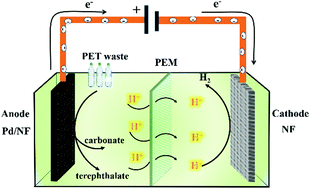Electrocatalytic reforming of waste plastics into high value-added chemicals and hydrogen fuel†
Abstract
The upcycling of waste plastic offers an attractive way to protect the environment and turn waste into value-added chemicals and H2 fuel. Herein, we report a novel electroreforming strategy to upcycle waste polyethylene terephthalate into high value-added chemicals, such as terephthalate and carbonate, over a Pd modified Ni foam catalyst. This system exhibits excellent electrocatalytic activity (400 mA cm−2 at 0.7 V vs. RHE) and high selectivity (95%)/faradaic efficiency (93%) for the product carbonate. Our work demonstrates a technology that can not only transform waste polyethylene terephthalate into value-added chemicals but also generate H2 fuel via an all-in-one electro-driven process.

- This article is part of the themed collection: ChemComm contributions to the United Nations Sustainable Development Goals


 Please wait while we load your content...
Please wait while we load your content...